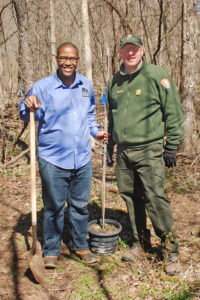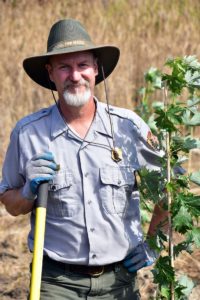This year, we are celebrating 50 years since the last burning of the Cuyahoga River. It’s a pretty big deal.
But the Cuyahoga did not improve on its own. It’s everyday people like YOU who have contributed to the river’s health. Here are some simple ways you can make sure our river stays healthy for years to come.

NPS Ranger Josh Bates works with NPCA representative and park volunteer LeAaron Foley
1. Stop littering and pick up trash you see along the river
2. Plant trees Trees and plants hold back sediment and reduce turbidity. Turbidity is the cloudiness or haziness of a fluid caused by large numbers of individual particles that are generally invisible to the naked eye, similar to smoke in air. The measurement of turbidity is a key test of water quality.
There are countless opportunities for you to volunteer and plant trees in our national park. By doing so, you will make a lasting difference in the Cuyahoga River’s water quality. Visit our volunteer page to learn more about the many opportunities to volunteer!
3. Turn off the water while you brush your teeth and take shorter showers: By conserving water, less wastewater will enter our rivers during heavy storm events through combined sewer overflow.
4. Buy organic produce Organic farms do not contribute to fertilizer runoff. Consider grocery shopping at a farm in Cuyahoga Valley National Park! To learn more about farming in our national park, visit the Countryside website.

Gary Whipple
5. Reduce, reuse, and recycle!
~~~~~~~~~~
Individual homeowners can also make a difference in the health of the Cuyahoga River Watershed by creating landscapes that will absorb maximum stormwater. Akron and greater Cleveland have combined sewers, a typical early design that carries sanitary sewage from homes, industrial waste, and stormwater all in one pipe to a treatment plant. But when heavy storms create a large amount of surface runoff, the pipes reach capacity, and some of the combined wastewater is diverted directly into streams, rivers and lakes.
The more stormwater that can be captured and absorbed before it reaches the sewer system, the more overflows can be minimized. Here are some steps you can take to make your landscape more water-absorbent:
Minimize impermeable surfaces, like asphalt.

Chris Davis
Plant trees. Tree leaves can catch a significant amount of rain before it even hits the ground, and some tree roots can absorb upwards of 100 gallons per day, according to CVNP plant ecologist Chris Davis.
Plant a rain garden. A rain garden is made in a depression to absorb runoff from impervious surfaces nearby. It features perennial, native plants that can handle standing water around their bases for a day or two after a storm. Rain gardens help filter water of pollutants before it reaches waterways.
Install a rain barrel. A rain barrel diverts stormwater runoff coming from the roof of a building, through a gutter into the barrel. You can then use it to water your garden.
Check these sources online for more information and how-to guides:
Summit Soil and Water Conservation District
Cuyahoga Soil and Water Conservation District
Northeast Ohio Regional Sewer District
Central Ohio Rain Garden Initiative





